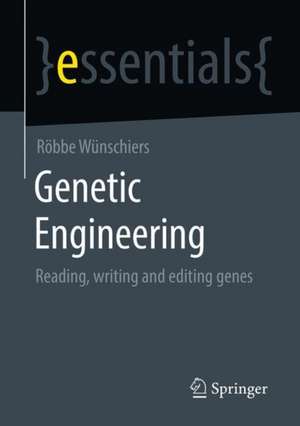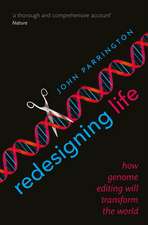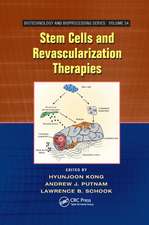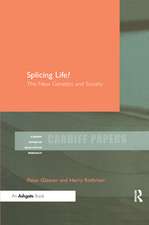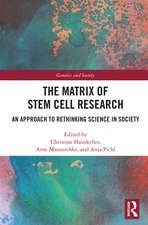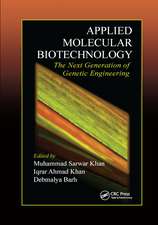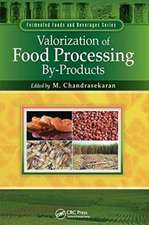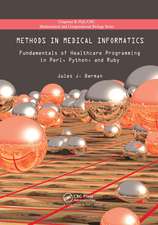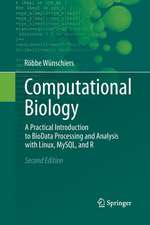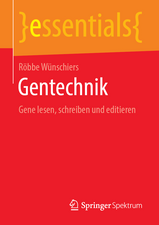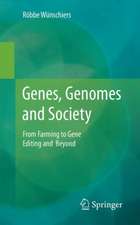Genetic Engineering: Reading, Writing and Editing Genes: essentials
Autor Röbbe Wünschiersen Limba Engleză Paperback – 6 iul 2021
This Springer essential is a translation of the original German 1st edition essentials, Gentechnik by Röbbe Wünschiers, published by The Editor(s) (if applicable) and The Author(s), under exclusive license to Springer Fachmedien Wiesbaden GmbH, part of Springer Nature in 2019. The translation was done with the help of artificial intelligence (machine translation by the service DeepL.com). A subsequent human revision was done primarily in terms of content, so that the book will read stylistically differently from a conventional translation. Springer Nature works continuously to further the development of tools for the production of books and on the related technologies to support the authors.
Din seria essentials
-
 Preț: 89.91 lei
Preț: 89.91 lei -
 Preț: 89.06 lei
Preț: 89.06 lei -
 Preț: 89.47 lei
Preț: 89.47 lei -
 Preț: 88.79 lei
Preț: 88.79 lei -
 Preț: 87.80 lei
Preț: 87.80 lei -
 Preț: 89.06 lei
Preț: 89.06 lei -
 Preț: 90.06 lei
Preț: 90.06 lei -
 Preț: 90.70 lei
Preț: 90.70 lei -
 Preț: 90.88 lei
Preț: 90.88 lei -
 Preț: 88.15 lei
Preț: 88.15 lei - 5%
 Preț: 82.54 lei
Preț: 82.54 lei -
 Preț: 89.97 lei
Preț: 89.97 lei -
 Preț: 89.47 lei
Preț: 89.47 lei -
 Preț: 89.47 lei
Preț: 89.47 lei -
 Preț: 75.98 lei
Preț: 75.98 lei -
 Preț: 90.18 lei
Preț: 90.18 lei -
 Preț: 89.47 lei
Preț: 89.47 lei -
 Preț: 89.27 lei
Preț: 89.27 lei -
 Preț: 88.49 lei
Preț: 88.49 lei -
 Preț: 88.49 lei
Preț: 88.49 lei -
 Preț: 88.86 lei
Preț: 88.86 lei -
 Preț: 89.06 lei
Preț: 89.06 lei - 5%
 Preț: 85.47 lei
Preț: 85.47 lei -
 Preț: 89.88 lei
Preț: 89.88 lei -
 Preț: 88.36 lei
Preț: 88.36 lei -
 Preț: 87.80 lei
Preț: 87.80 lei -
 Preț: 89.84 lei
Preț: 89.84 lei -
 Preț: 123.11 lei
Preț: 123.11 lei - 5%
 Preț: 85.54 lei
Preț: 85.54 lei - 5%
 Preț: 84.42 lei
Preț: 84.42 lei -
 Preț: 90.18 lei
Preț: 90.18 lei -
 Preț: 73.76 lei
Preț: 73.76 lei -
 Preț: 93.57 lei
Preț: 93.57 lei -
 Preț: 122.96 lei
Preț: 122.96 lei -
 Preț: 88.92 lei
Preț: 88.92 lei -
 Preț: 89.24 lei
Preț: 89.24 lei -
 Preț: 89.88 lei
Preț: 89.88 lei -
 Preț: 88.49 lei
Preț: 88.49 lei -
 Preț: 88.15 lei
Preț: 88.15 lei -
 Preț: 90.47 lei
Preț: 90.47 lei -
 Preț: 89.41 lei
Preț: 89.41 lei -
 Preț: 89.65 lei
Preț: 89.65 lei -
 Preț: 89.47 lei
Preț: 89.47 lei -
 Preț: 90.41 lei
Preț: 90.41 lei -
 Preț: 73.76 lei
Preț: 73.76 lei -
 Preț: 26.24 lei
Preț: 26.24 lei - 5%
 Preț: 82.81 lei
Preț: 82.81 lei - 5%
 Preț: 69.91 lei
Preț: 69.91 lei -
 Preț: 86.39 lei
Preț: 86.39 lei
Preț: 169.06 lei
Nou
32.36€ • 35.16$ • 27.20£
Carte tipărită la comandă
Livrare economică 21 aprilie-05 mai
Specificații
ISBN-10: 3658324023
Ilustrații: IX, 41 p. 1 illus.
Dimensiuni: 148 x 210 mm
Greutate: 0.07 kg
Ediția:1st ed. 2021
Editura: Springer Fachmedien Wiesbaden
Colecția Springer
Seriile essentials, Springer essentials
Locul publicării:Wiesbaden, Germany
Cuprins
How is the genetic material read and what does the information say?.- Which methods can be used to modify the genetic material and what are the goals?.- Who owns genetic information and what can be marketed and how?.- How does the environment affect the genetic material?.- Do we want a liberalization of genetic engineering as a civic science?
Notă biografică
Röbbe Wünschiers holds a doctorate in plant physiology and a habilitation in genetics. He researches and teaches as professor of biochemistry and molecular biology at the University of Applied Sciences Mittweida.
Textul de pe ultima copertă
The content
- How is the genetic material read and what does the information say?
- Which methods can be used to modify the genetic material and what are the goals?
- Who owns genetic information and what can be marketed and how?
- How does the environment affect the genetic material?
- Do we want a liberalization of genetic engineering as a civil science?
The target groups
Caracteristici
Explains the risks and opportunities of genetic surgery
Illuminates the responsibility of humanity as well as moral aspects in dealing with genetic engineering
Descriere
This essential should serve as an introduction for a contemporary public discussion on genetic engineering. Genetic engineering affects us all in many areas and we must dare to think more colorful and further. In fact, the complete genetic material of viruses and bacteria can already be chemically produced and "brought to life". With genetic surgery, medicine is at a crossroads: do we want to treat hereditary diseases or "repair" them genetically? And the analysis of thousands of human genetic material reveals information that is related to complex diseases, but also to characteristics such as intelligence. How should we use this knowledge? The question is hardly whether we want genetic engineering, but rather how we use it.
This Springer essential is a translation of the original German 1st edition essentials, Gentechnik by Röbbe Wünschiers, published by The Editor(s) (if applicable) and The Author(s), under exclusive license to Springer Fachmedien Wiesbaden GmbH, part of Springer Nature in 2019. The translation was done with the help of artificial intelligence (machine translation by the service DeepL.com). A subsequent human revision was done primarily in terms of content, so that the book will read stylistically differently from a conventional translation. Springer Nature works continuously to further the development of tools for the production of books and on the related technologies to support the authors.
